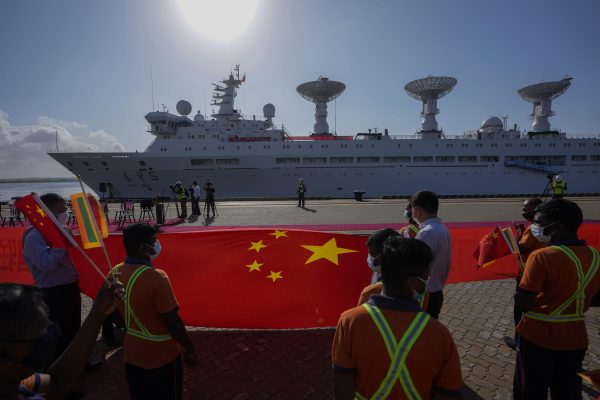Harsha Kakar
After a delay of six days, the Chinese ship Yuan Wang 5 docked in Chinese run Sri Lankan port Hambantota on 16th Aug, despite concerns of India and the US. The ship is scheduled to remain in the port till 22nd Aug, possibly for refuelling and replenishments. The ship was earlier scheduled to dock on 11th Aug but was delayed on India’s request. During this period the Chinese ambassador to Sri Lanka worked with the Sri Lankan leadership to ensure thatall issues concerning the docking of the ship were settled. The ship was compelled to cut speed while travelling from China, though made no other halt, awaiting clearance for docking in Hambantota. The Chinese claimed it was halting solely for refuelling and crew refreshment. The ship carries a crew of approximately 2000.
Hambantota port in Sri Lanka, close to Columbo, was constructed with a Chinese loan in 2010. What was of concern was that the ship docked in Hambantota and not Columbo, where all ships transiting make refuelling halts. Since the port is Chinese run, there were concerns that during its halt Yuan Wangcould monitor activities in military and DRDO facilities in South India. Hambantota port was a failure from its inception as ships preferred Columbo as the offloading and halting station. Its construction did not add to revenues, compelling the Sri Lankan government to hand it over to the Chinese company, Chinese Merchant Ports, on a 99-year lease, to cut loan defaults. The handing over agreement was signed by Ranil Wickremesinghe, the then Sri Lankan PM, currently the President.
India’s concerns were genuine but for the Sri Lankan Government there were limited choices. India considered the ship as military, as it is manned by Chinese navy sailors, though earmarked for satellite monitoring. However, the Chinese described the ship as a research ship, thereby offsetting the military angle. Chinese naval ships have docked in Hambantota earlier, despite Indian concerns. Earlier in 2014, two Chinese submarines, including a nuclear-powered submarine, halted in Hambantota on claims of refuelling.For India, regular naval vessel visits could result in Hambantota becoming a permanent Chinese naval base.
Yuan Wang has capabilities of trackingIndian ballistic missiles fired from the Abdul Kalam testing range off the Odisha coast. This would enable them to gauge the range and accuracy of Indian missiles, currently under development and testing. It can alsomonitor communications at ranges of 750 Kms bringing Indian defence installations, located in South India, within its reach. The ship also conducts oceanic surveys, essential for submarine operations, a matter of concern for India.
The docking of the ship became a diplomatic battle between India and China. Hence, it was received amongst others by the Chinese Ambassador to Columbo, projecting victory of the Chinese. On the docking the Chinese foreign ministry spokesperson in Beijing stated, ‘(objections to the docking are) completely unjustified for certain countries to cite the so-called security concerns to pressure Sri Lanka.’ The technical capabilities of the ship are so secretive that even the Chinese ambassador, who was present at the time of its docking, was not permitted onboard.
As a policy, India monitors movement of all Chinese naval vessels in the Indian Ocean and was therefore monitoring the movement of Yuan Wang 5. The Sri Lankan government had repeatedly stated that it would never allow Hambantota port to be employed for military purposes, though they have limited control over the port. Thus, its attempts to stall the docking of the ship failed. The Chinese ambassador met the President and conveyed Chinese intent. Finally Sri Lanka defended its decision by stating that the ship came to the port under the category of a ‘research ship.’
The Chinese ambassador possibly pushed Beijing’s intent for docking the ship by insisting that since the port is under the Chinese and the ship does not carry war-like stores, its movement cannot be stopped. Further, Beijing always hangs the sword of repayment of dues over Sri Lanka, thereby influencing its decisions. There are a few opposition political parties which are China biased, members of which were even present at the ceremony celebrating the docking of Yuan Wang. China defended its decision to berth in Hambantota claiming, ‘marine scientific research activities of the Yuan Wang 5 are consistent with international law and international common practice.’
For India, this could be the commencement of Chinese naval vessels halting in Hambantota. China could militarize the port in the event of an Indo-China conflict. Sri Lanka is caught between the devil and the deep sea. Though close to India and dependent on it for aid, especially after its economic collapse, it owes China USD 8 Billion. India has provided it with USD 4 Billion aid in its moment of crisis, while China has maintained silence. Thus, India can push Sri Lanka tosome levels, however its dues to China will influence decision making.
Post the Sri Lankans announcing their decision to permit docking of the ship, the Indian government gave no statement, other than mentioning that it monitors all activities concerning national security. Quite possibly India understood the Sri Lankan dilemma, or the subject was discussed at the highest level. India gifted a Dornier aircraft to Sri Lanka just a day prior to the arrival of the ship, implying that the docking of the Chinese ship has no impact on India-Sri Lanka relations.
The ship has departed from Hambantota, however, will remain in the Indian Ocean for next few months, monitoring Indian activities as also conducting Oceanic surveys. Indian naval agencies will continue observing the ship as it operates in areas of India’s interests. There are also reports that India placed a signal shield employing satellites and naval vessels to block efforts of monitoring Indian activities by the Chinese vessel. However, this cannot be verified. What is more important is for India to develop similar capabilities which it can deploy in the South China Sea, as a tit for tat move.
The author is Major General (Retd)


